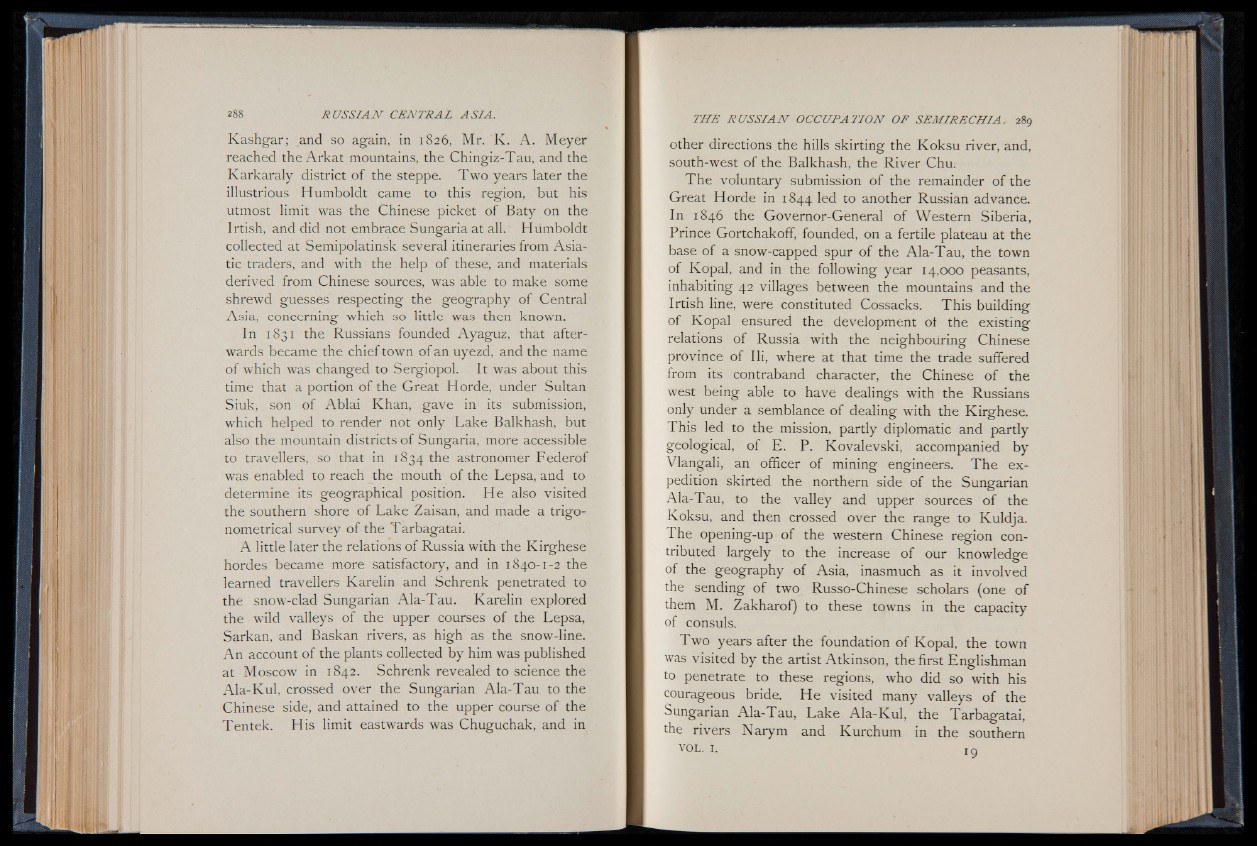
Kashgar; and so again, in 1826, Mr. K. A. Meyer
reached the A rkat mountains, the Chingiz-Tau, and the
Karkaraly district of the steppe. Two years later the
illustrious Humboldt came to this reOgi on,’ but his
utmost limit was the Chinese picket of Baty on the
Irtish, and did not embrace Sungaria at all. Humboldt
collected at Semipolatinsk several itineraries from Asiatic
traders, and with the help of these, and materials
derived from Chinese sources, was able to make some
shrewd guesses respecting the geography o f Central
Asia, concerning which so little was then known.
In 1831 the Russians founded Ayaguz, that afterwards
became the chief town of an uyezd, and the name
of which was changed to Sergiopol. It was about this
time that a portion of the Great Horde, under Sultan
Siuk, son of Ablai Khan, gave in its submission,
which helped to render not only Lake Balkhash, but
also the mountain districts of Sungaria, more accessible
to travellers, so that in 1834 the astronomer Federof
was enabled to reach the mouth of the Lepsa, and to
determine its geographical position. He also visited
the southern shore of Lake Zaisan, and made a trigonometrical
survey of the Tarbagatai.
A little later the relations o f Russia with the Kirghese
hordes became more satisfactory, and in 1840-1-2 the
learned travellers Karelin and Schrenk penetrated to
the snow-clad Sungarian Ala-Tau. Karelin explored
the wild valleys of the upper courses of the Lepsa,
Sarkan, and Baskan rivers, as high as the snow-line.
An account of the plants collected by him was published
at Moscow in 1842. Schrenk revealed to science the
Ala-Kul, crossed over the Sungarian Ala-Tau to the
Chinese side, and attained to the upper course of the
Tentek. His limit eastwards was Chuguchak, and in
other directions the hills skirting the Koksu river, and,
south-west of the Balkhash, the River Chu.
The voluntary submission of the remainder of the
Great Horde in 1844 led to another Russian advance.
In 1846 the Governor-General of Western Siberia,
Prince Gortchakoff, founded, on a fertile plateau at the
base of a snow-capped spur of the Ala-Tau, the town
of Kopal, and in the following year 14,000 peasants,
inhabiting 42 villages between the mountains and the
Irtish line, were constituted Cossacks. This building
of Kopal ensured the development o f the existing
relations of Russia with the neighbouring Chinese
province of Ili, where at that time the trade suffered
from its contraband character, the Chinese of the
west being able to have dealings with the Russians
only under a semblance of dealing with the Kirghese.
This led to the mission, partly diplomatic and partly
geological, of E. P. Kovalevski, accompanied by
Vlangali, an officer of mining engineers. The expedition
skirted the northern side of the Sungarian
Ala-Tau, to the valley and upper sources o f the
Koksu, and then crossed over the range to Kuldja.
The opening-up of the western Chinese region contributed
largely to the increase o f our knowledge
of the geography of Asia, inasmuch as it involved
the sending of two Russo-Chinese scholars (one of
them M. Zakharof) to these towns in the capacity
of consuls.
Two years after the foundation o f Kopal, the town
was visited by the artist Atkinson, the first Englishman
to penetrate to these regions, who did so with his
courageous bride. He visited many valleys o f the
Sungarian Ala-Tau, Lake Ala-Kul, the Tarbagatai,
the rivers Narym and Kurchum in the southern
VOL. I . ic )